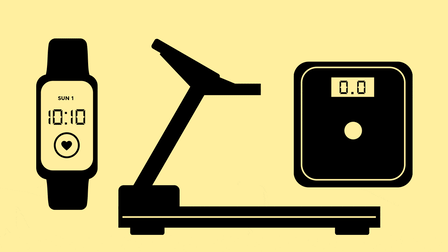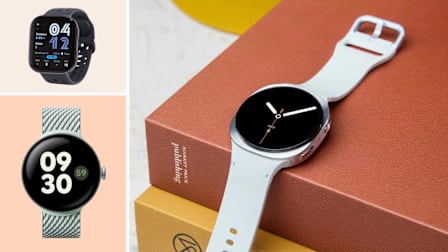Garmin Vivosmart 5 Fitness Tracker Review
This fitness tracker's tiny black-and-white display is unimpressive, but Garmin's robust smartphone app should please serious fitness devotees
When you shop through retailer links on our site, we may earn affiliate commissions. 100% of the fees we collect are used to support our nonprofit mission. Learn more.

The Garmin Vivosmart 5 is a compact, premium-priced fitness tracker with a small 0.9-inch monochrome display and access to a deep selection of high-performance fitness metrics on Garmin’s smartphone app.
The Vivosmart 5 is a bit bigger and bulkier than the previous Vivosmart 4. And while some fitness trackers have larger displays and interchangeable bands that make them suitable for all-day wear, the Garmin’s small size and sporty styling suggest that it’s designed primarily to be worn during a workout.
The Vivosmart 5 carries an interesting collection of features, with some welcome additions compared with most fitness trackers (like stress management tools) but also some puzzling omissions for a tracker in this $150 price range (the lack of onboard GPS, found on many higher-end models, for tracking runs, rides, or hikes.)
Notable Features
- Blood oxygen sensor: The Vivosmart 5 has a built-in blood oxygen sensor, which is used to improve the sleep tracking accuracy in Garmin’s smartphone app.
- 7-day battery life: The claimed battery life is pretty average by fitness tracker standards, though it is significantly longer than many smartwatches’.
- Find My Phone: You can use your Vivosmart 5 to help find your smartphone by sending an audible alert to the missing device.
- Support for Android and iOS: The Garmin app works just fine on either an iPhone or an Android phone. And because the Vivosmart 5 doesn’t have built-in GPS, you’re likely to be bringing your phone with you on runs or rides.
How Well Does the Vivosmart 5 Work?
The first thing to know about the Vivosmart 5 is that it comes in different sizes. I found that the small-medium size just barely fit me–one more notch on the band and it would have been too small. Pay attention to sizing before you buy; if your wrist is bigger than mine—6¾ inches—you’ll want to order a large. The swappable band’s material has an interesting, almost clothlike texture, but it’s still silicone, which can cause skin irritation for some people. I experienced that during a longer-term evaluation of Garmin’s earlier Vivosmart 4, but not with the Vivosmart 5.
The Vivosmart 5 charges with a dedicated charging cable that’s a bit annoying. It’s only a foot long, and while the connection is solid enough, if you lose it, finding a replacement will be a pain. A USB-C connection would have been welcome. Garmin’s weeklong claimed battery life will, at least, keep you from using the charger that often.
The Vivosmart 5 is somewhat bigger and bulkier overall than its predecessor, the Vivosmart 4, but the display is still very small. The monochrome screen feels a bit dated, especially for a premium-priced product. The display in the center of the screen, usually for elapsed time, is legible. But the much smaller readouts above and below, for metrics like distance, pace, and step count, are so tiny that they’re hard to read while exercising hard, or even walking. Using the Garmin outdoors in bright sunlight makes the problem worse.
The Vivosmart 5 has an interesting array of features. It offers high-end functionality like stress measurement, and a blood oxygen sensor. But at the same time, it lacks common features like an option for contactless payments. It also lacks an EKG sensor or a skin temperature sensor, which are both features found on many fitness trackers and most smartwatches. The biggest omission is the lack of stand-alone GPS, which means you’ll have to carry along your smartphone to track your route when you’re exercising outdoors.
The Vivosmart 5 does boast compatibility with third-party apps like Strava, Peloton, and Apple Health. And indeed the Vivosmart 5 is really at its best when you stop using that tiny display and delve into the trove of information on the company’s robust smartphone app. Garmin devices have been aimed at serious athletes, though they’re easy enough for novices. The Vivosmart 5’s app gives you access to high-end metrics like VO₂ Max (the maximum amount of oxygen your body can use during exercise) and long-term training trends, so, for example, you can go back and analyze your workouts before you ran your personal best 10K last spring to see what you were doing right.
The major issue with the Garmin Vivosmart 5, aside from that small display, is its $150 price. For starters, Garmin models don’t go on sale very often, so you’re likely to actually pay that rather high price. Its main competition among fitness trackers is the Fitbit Charge 5, which has a significantly larger AMOLED color display and a more premium stainless steel case, as well as features like built-in GPS which the Garmin lacks. The Fitbit also retails for $150 but, unlike the Garmin, it’s often on sale. There are also a number of inexpensive smartwatches with more functionality and bigger displays at around the same price as the Garmin.
Consumer Reports has full test results for the Garmin Vivosmart 5 and 25 other fitness trackers.
Who Is the Vivosmart 5 For?
The Garmin Vivosmart 5 is for a rather serious athlete who’s fine with a fitness tracker that’ll be worn for workouts only. For some, the less-than-stellar display, and a few missing features will represent a reasonable trade-off to gain access to Garmin’s robust smartphone app.
How Consumer Reports Tests Fitness Trackers
Our trained testers test dozens of fitness trackers in our dedicated labs in Yonkers, N.Y. They begin with the basics, evaluating ease of interaction (how fast a watch’s display responds to our inputs) and ease of pairing, as well as generating an overall ease-of-use score. Our techs then work up a sweat when they test step counts and heart rate monitoring, in which the data from the devices are compared with medical-grade monitors.
We also test watches for ruggedness. We evaluate any claims that models make for water resistance, using a pressure tank that can mimic submersion in deep water. For instance, based on the claims made by their manufacturers, some watches are tested at the equivalent of 164 feet for 10 minutes. Our testers also employ specially designed instruments to test the display for scratch resistance.































